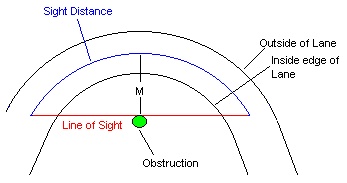
Horizontal Curve Sight Distance
Once you have a radius that seems to connect the two previously
disjointed sections of roadway safely and comfortably, you need to make sure that you have
provided an adequate stopping sight distance throughout your horizontal curve.
Sight distance can be the controlling aspect of horizontal curve design where
obstructions are present near the inside of the curve. To determine the actual sight
distance that you have provided, you need to consider that the driver can only see the
portion of the roadway ahead that is not hidden by the obstruction. In addition, at
the instant the driver is in a position to see a hazard in the roadway ahead, there should
be a length of roadway between the vehicle and the hazard that is greater than or equal to
the stopping sight distance. See figure 1.0 below.

Figure 1.0: Sight Distance
Because the sight obstructions for each curve will be different, no general method for
calculating the sight distance has been developed. If you do have a specific
obstruction in mind, however, there is an equation that might be helpful. This equation
involves the stopping sight distance, the degree of the curve, and the location of the
obstruction.
M = (5730/D)*(1 - cos(SD/200))
Where:
M = Distance from the center of the inside lane to the obstruction (ft.)
D = Degree of the curve. Where R = 5730/D
S = Stopping sight distance (ft)
R = Radius of the curve (ft)
Once your rough design has been adjusted to accommodate the sight distance
restrictions, and you are satisfied with the aesthetic and financial consequences of your
superelevation scheme, you can begin to polish your design into its final form.
|